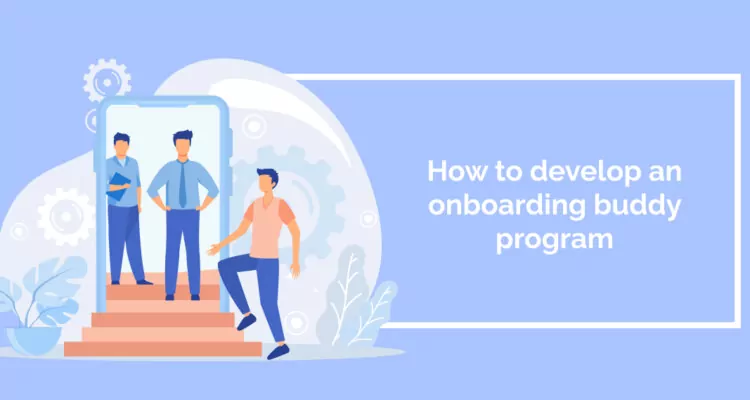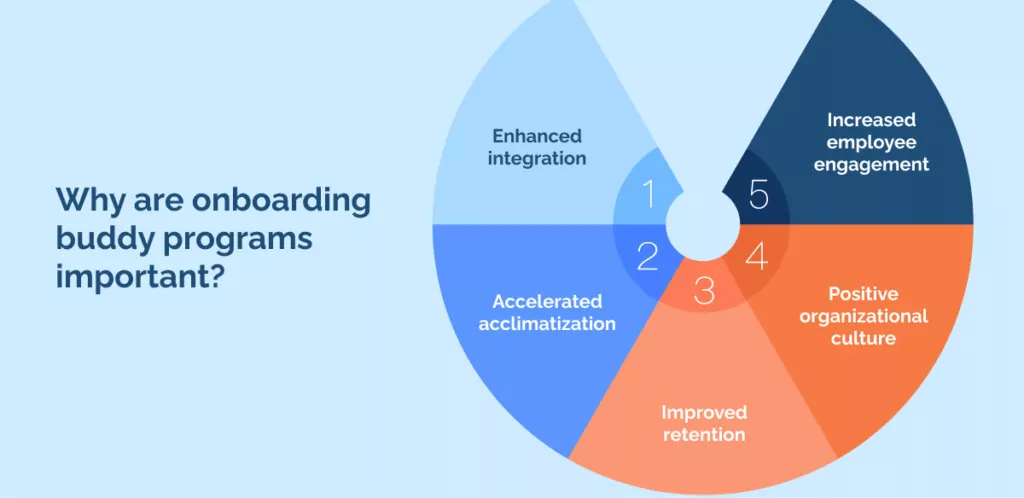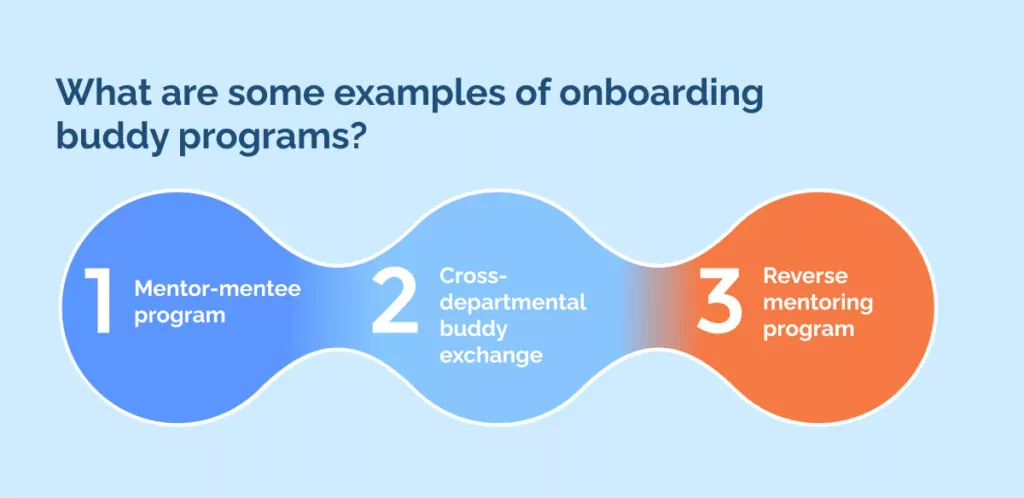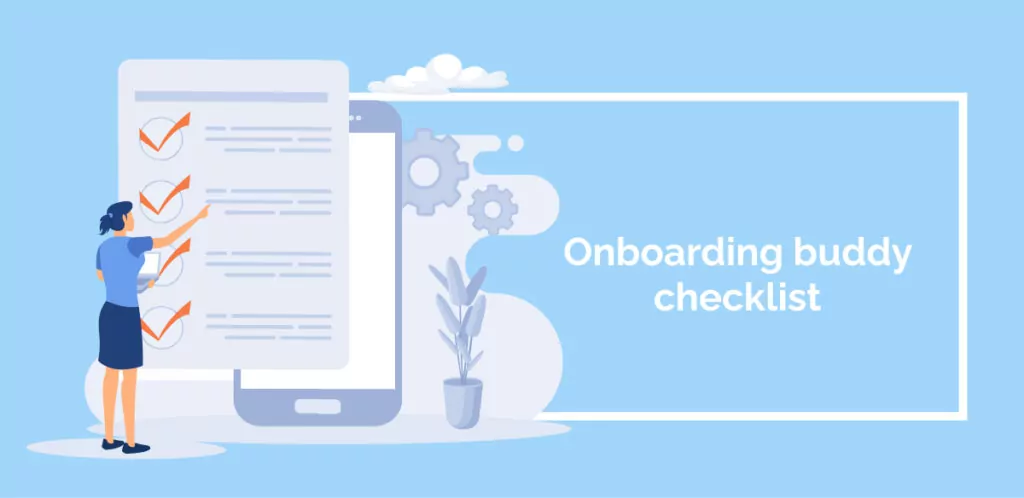
In modern workplaces, a seamless onboarding experience should be a given. After all, the initial days of an employee’s tenure set the tone for their entire professional journey, influencing job satisfaction, productivity, and retention.
Recognizing the pivotal role of social integration in new employee orientation, HR leaders are increasingly turning to onboarding buddy programs. This proactive approach represents a smoother transition for new hires and cultivates a sense of belonging and camaraderie within the team.
According to Brandon Hall Group’s research, organizations with a robust onboarding process enhance new hire retention by 82% and boost productivity by more than 70%.
The data above reveals the importance of a well-structured onboarding process in retaining new talent and significantly elevating overall workforce productivity. This underscores the strategic importance of effective onboarding strategies in organizational success.
This article will explore the art of crafting an effective onboarding buddy program. From providing illuminating real-world examples to a practical checklist, we empower HR leaders to transform onboarding into a collaborative journey.
What is an onboarding buddy program?
An onboarding buddy program pairs new hires with experienced employees to enable a smoother integration into the workplace.
This mentorship-style initiative is designed to provide practical insights, guidance, and support during the critical early days of employment. HR leaders recognize its significance in fostering a sense of belonging, accelerating acclimatization, and cultivating a positive organizational culture.
Investing in an onboarding buddy program ensures new team members receive valuable firsthand knowledge, enabling them to navigate company dynamics more effectively. HR leaders are crucial in facilitating this process and fostering a collaborative environment.
Buddy programs improve the onboarding journey and create lasting employee contentment and involvement. Ultimately, it strengthens the organization’s success by promoting a harmonious and well-integrated workforce.
Why are onboarding buddy programs important?

In human resources, an onboarding buddy program goes beyond organizational protocol, becoming the cornerstone for fostering organizational values.
Every new hire is intricately woven into a fabric of mentorship, support, and engagement, providing HR leaders with a transformative tool for cultivating a culture of integration, retention, and sustained employee loyalty.
Let’s explore the benefits further:
Enhanced integration
Onboarding buddies serve as cultural ambassadors, aiding new hires in navigating the intricacies of company values, norms, and expectations. This proactive approach ensures that employees feel welcomed and integrated into the organization, fostering a sense of community and belonging.
Accelerated acclimatization
Assigned mentors play a pivotal role in accelerating the acclimatization process for new employees. Through personalized guidance, they help navigate organizational structures, understand role expectations, and quickly adapt to the work environment. This accelerates the learning curve, allowing newcomers to contribute meaningfully and efficiently from the outset.
Improved retention
Onboarding buddies become support pillars, creating a positive onboarding experience and significantly contributing to higher employee satisfaction. This positive start sets the tone for continued job satisfaction, reducing turnover rates and associated costs. The bond formed with a mentor often extends beyond the onboarding phase, creating lasting connections within the organization.
Positive organizational culture
Onboarding buddy programs actively shape and reinforce a positive organizational culture. Promoting mentorship, teamwork, and open communication enables a workplace environment that values collaboration, ensuring employees feel supported in their professional growth. This aligns seamlessly with HR’s broader objective of developing a culture that fosters inclusivity and support.
Increased employee engagement
Onboarding buddies play a crucial role in engaging new hires emotionally and intellectually. Mentors play a pivotal role in fostering heightened job satisfaction, motivation, and overall commitment by offering personalized guidance, addressing concerns, and providing insights. This engagement facilitates a smoother onboarding journey and sets the foundation for sustained employee loyalty and dedication.
How to create an onboarding buddy program
HR leaders hold the key to creating a cohesive and supportive onboarding process.
Developing an onboarding buddy program emerges as a strategic initiative, providing leaders with a powerful mechanism to facilitate mentorship, bolster team integration, and cement a foundation for enduring employee satisfaction and loyalty.
Let’s look at the steps involved in creating a successful buddy onboarding program:
Needs assessment and goal definition
Immerse yourself in your company’s onboarding systems and discern the unique needs and aspirations of incoming talent. Start by defining pragmatic, achievable goals aligning individual ambitions with organizational expectations.
A deliberate approach sets a robust foundation for an onboarding buddy program designed to address every new team member’s distinctive challenges and aspirations, ensuring a tailor-made integration into the company fabric.
- Goals: Study the company’s onboarding systems to identify new hire needs. Establish clear goals, such as understanding and aligning individual aspirations with organizational expectations, to ensure a purposeful onboarding experience.
- Objectives: Conduct a comprehensive analysis of onboarding requirements and define specific goals aligned with individual and organizational expectations.
- Measuring Success: Evaluate the accuracy of needs assessment through feedback from new hires. Measure goal achievement by assessing the alignment between individual aspirations and organizational expectations.
Selecting and training buddies
Identify competent and truly engaging employees renowned for their exceptional interpersonal finesse. Highlight their path through a training regimen that extends beyond procedural knowledge, exploring the art of effective communication and mentorship.
A meticulous selection and training process guarantees that buddies emerge as repositories of information and as catalysts for cultivating positive and enduring relationships with their mentees.
- Goals: Identify engaging employees with exceptional interpersonal skills. Train them in procedures, effective communication, and mentorship, ensuring buddies cultivate positive relationships.
- Objectives: Identify employees with exceptional interpersonal agility and provide training that extends beyond procedural knowledge.
- Measuring Success: Assess buddy engagement and interpersonal skills through mentee feedback. Evaluate the effectiveness of training through improved mentorship dynamics.
Customized pairings
Explore a spectrum of personalities, job roles, and individual preferences to guarantee that every alliance between a mentor and a new team member is harmonious and symbiotic.
Cultivating an environment that naturally fosters open communication and delivers effective guidance is integral to the success of the mentorship alliance between a mentor and a new team member.
Tailoring pairings to individuals’ specific needs and nuances establishes a foundation of camaraderie and mutual understanding right from the inception.
- Goals: Move beyond generic pairings by considering personalities, roles, and preferences, ensuring each union between a buddy and a new hire is harmonious and symbiotic.
- Objectives: Tailor pairings based on personalities, roles, and preferences. Foster an environment conducive to open communication and effective guidance.
- Measuring Success: Evaluate the harmony and effectiveness of pairings through feedback. Assess the level of open communication and guidance in paired relationships.
Orientation and Communication
Launch the onboarding journey with a captivating orientation, introducing the organizational intricacies and the dynamic duo of buddies and new hires.
Articulate expectations with precision and cultivate an open communication channel that transcends the conventional boundaries of mentorship.
Establishing a robust communication framework ensures that mentees feel supported and deeply ingrained in the company’s culture, facilitating a smoother and more profound integration.
- Goals: Launch onboarding with a captivating orientation that articulates expectations and fosters open communication, intricately weaving new hires into the fabric of the company culture.
- Objectives: Conduct an engaging orientation introducing buddies and new hires. Establish a robust communication framework for seamless integration.
- Measuring Success: Assess the effectiveness of the orientation through participant feedback. Measure communication success by evaluating mentee integration and understanding.
Resource development
Empower employees with a treasure trove of resources curated into a comprehensive handbook with insights, templates, and real-world examples.
This resource bank is a navigational tool for mentors, offering guidance and a reservoir of best practices. Onboarding buddy programs, armed with practical resources, elevate the quality of support provided, ensuring a consistent and invaluable onboarding experience for the new hires under their wings.
- Goals: Empower buddies with a comprehensive toolkit, ensuring they have practical resources to guide new hires through insights, templates, and real-world examples.
- Objectives: Develop a comprehensive handbook with valuable resources. Equip buddies with practical tools for effective mentorship.
- Measuring Success: Evaluate buddy effectiveness through resource utilization feedback. Measure the impact of resources on mentee onboarding experiences.
Regular check-ins and feedback loops
Develop a continuous improvement culture by integrating regular check-ins between buddies and fledgling colleagues. These periodic arrangements provide fertile ground for collaborative problem-solving and organic platforms for cultivating trust and rapport.
Embracing feedback as a catalyst for iterative enhancements ensures that the onboarding buddy program remains agile and responsive to the evolving needs of both mentors and mentees, fostering a dynamic and adaptive mentorship environment.
- Goals: Cultivate a culture of continuous improvement through regular check-ins, providing opportunities for collaborative problem-solving and building trust.
- Objectives: Establish a routine for regular check-ins between buddies and new hires. Encourage feedback as a catalyst for iterative program enhancements.
- Measuring Success: Assess the frequency and quality of check-ins through participant feedback. Measure the impact of feedback on program adaptability and effectiveness.
Celebrating milestones
Infuse your onboarding journey with a spirit of celebration, marking key milestones not just as achievements but as shared victories.
Acknowledge and celebrate the triumphs, both big and small, of both mentors and mentees. This intentional recognition boosts morale and reinforces the significance of collaborative efforts, creating a positive atmosphere that amplifies the team’s sense of accomplishment.
- Goals: Infuse the onboarding journey with celebration, acknowledging achievements, big and small, to propel morale and reinforce the significance of collaborative efforts.
- Objectives: Recognize and celebrate key milestones in the onboarding journey. Foster a positive atmosphere through intentional acknowledgment.
- Measuring Success: Assess the impact of celebrations on morale through participant feedback. Measure the influence of acknowledgment on team camaraderie and motivation.
Continuous evaluation and optimization
Embrace an ethos of perpetual refinement, diligently evaluating the onboarding buddy program with a discerning eye.
Use surveys, feedback mechanisms, and performance metrics to gauge effectiveness. A data-driven approach is the compass for ongoing optimization, ensuring the program evolves organically with organizational goals and employee needs.
The result is a consistently impactful and adaptive mentorship system that is a testament to the organization’s commitment to nurturing a culture of integration, retention, and sustained employee loyalty.
- Goals: Embrace perpetual refinement by diligently evaluating the onboarding buddy program utilizing surveys, feedback mechanisms, and performance metrics.
- Objectives: Conduct regular evaluations using surveys and feedback mechanisms. Utilize performance metrics to gauge program effectiveness.
- Measuring Success: Assess the effectiveness of continuous evaluations through participant feedback. Measure the impact of optimization on program evolution and alignment with organizational goals.
What are some examples of onboarding buddy programs?

In response to the dynamic nature of the modern workplace, innovative companies are redefining their approaches to employee onboarding.
This section explores a variety of onboarding buddy programs, showcasing creative initiatives to integrate and support new hires.
1. Mentor-mentee program
This classic buddy program pairs new employees with experienced mentors who guide them through onboarding, share insights into the company culture, and provide career advice.
Example: A technology company assigns each new software developer a mentor who has been with the company for several years. The mentor helps the new hire understand coding standards, project workflows, and introduces them to key team members.
2. Cross-departmental buddy exchange
This innovative program promotes cross-functional collaboration by pairing employees from different departments. It encourages a broader understanding of the organization and fosters communication between diverse teams.
Example: A manufacturing company pairs a marketing specialist with a production team member for a month-long buddy exchange. This allows each employee to learn about the challenges and priorities of the other’s department, promoting a holistic view of the company.
3. Reverse mentoring program
In this unique approach, younger or less experienced employees are paired with more senior colleagues, allowing for a two-way knowledge exchange. Younger employees can share insights on technology, industry trends, and fresh perspectives, while senior employees offer guidance based on their experience.
Example: A financial institution pairs seasoned executives with younger employees in a reverse mentoring initiative. Younger employees share their expertise in digital marketing and social media trends, while the executives provide insights into leadership and industry dynamics.
Onboarding buddy checklist

Explore the future of onboarding strategies with our onboarding buddy checklist and uncover ten precise and technically charged checkpoints designed to propel your organization into a new realm of seamless integration.
From strategic objectives to automated milestones, this checklist is your roadmap to elevating the buddy onboarding program experience.
- 1. Forge Strategic Onboarding Goals: Develop SMART objectives that align the onboarding buddy program with organizational KPIs, ensuring a precise and impactful integration process.
- 2. Curate Expert Mentors: Identify proficient employees with a deep grasp of company tech stacks and methodologies to serve as onboarding buddies, bridging the knowledge gap for new hires.
- 3. Buddy Bootcamp 2.0: Conduct immersive and tech-centric training sessions, incorporating simulations and hands-on exercises to equip onboarding buddies with the technical prowess required for effective guidance.
- 4. Digital Dialogues: Establish a streamlined communication protocol leveraging collaboration tools, ensuring onboarding buddies and new hires seamlessly exchange information, queries, and updates.
- 5. Personalized Tech Tracks: Implement an algorithm-driven approach to customize the onboarding journey, tailoring technical training paths based on each new hire’s skill set and role requirements.
- 6. Virtual Networking Experiences: Organize online networking events and virtual meet-and-greets, leveraging platforms like Slack or Zoom to facilitate meaningful connections among new hires and their tech-savvy peers.
- 7. Resource Repository: Create a centralized digital repository for technical documentation, coding best practices, and project templates, empowering onboarding buddies to efficiently share essential resources with new hires.
- 8. Data-Driven Feedback Loops: Implement analytics tools to gather quantitative feedback on the onboarding process, utilizing data insights to optimize the program for increased efficiency and effectiveness.
- 9. Milestone Automation: Integrate milestone tracking systems that automatically recognize and celebrate key achievements in the onboarding process, fostering a tech-infused culture of acknowledgment.
- 10. Agile Evaluation Framework: Employ agile methodologies for continuous evaluation and adaptation of the onboarding buddy program, utilizing retrospectives and feedback loops to iterate on technical and procedural enhancements.
Enhancing organizational success through effective onboarding buddy programs
Developing a successful onboarding buddy program is a strategic investment in the future of your organization. By pairing new hires with experienced employees, you create a supportive, welcoming environment that not only speeds up the integration process but also fosters a culture of collaboration and mutual growth.
This article has given you a clear plan for establishing a buddy program for new hires, with practical instructions and useful suggestions. Remember, you can gauge the effectiveness of an onboarding program through the increased retention rates, heightened productivity, and enhanced job satisfaction of your employees.
Embrace these strategies to ensure your new hires feel valued and equipped to contribute to your organization’s success from day one. Let’s make the onboarding experience not just a step but a significant leap towards building a cohesive, dynamic, and thriving workplace.
WalkMe Team
WalkMe spearheaded the Digital Adoption Platform (DAP) for associations to use the maximum capacity of their advanced resources. Utilizing man-made consciousness, AI, and context-oriented direction, WalkMe adds a powerful UI layer to raise the computerized proficiency, everything being equal.



